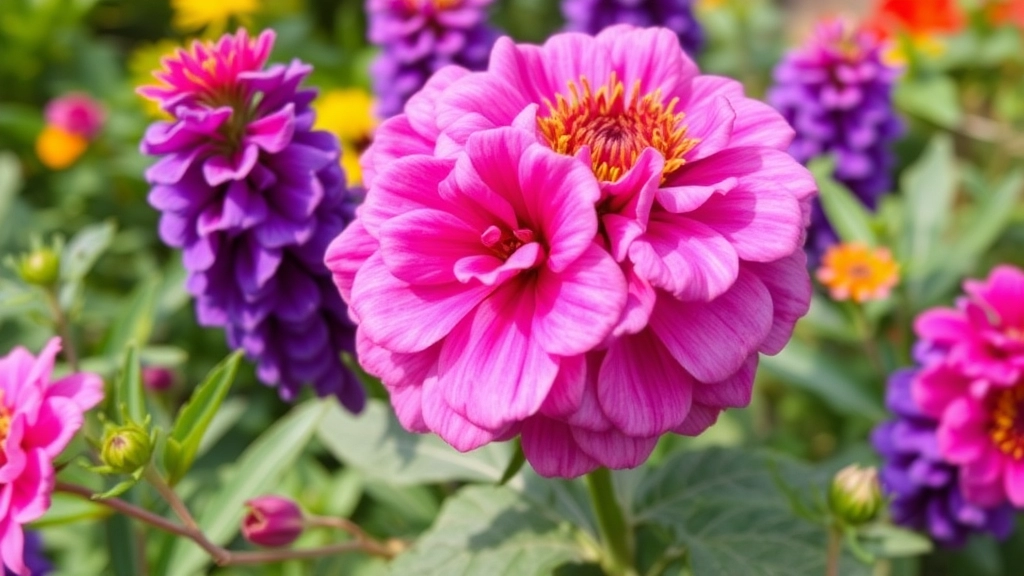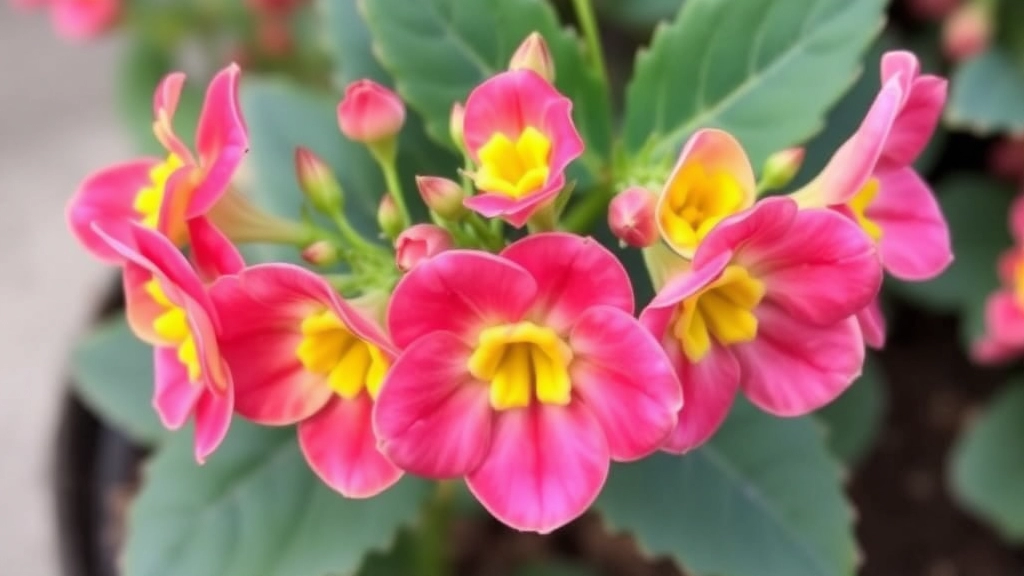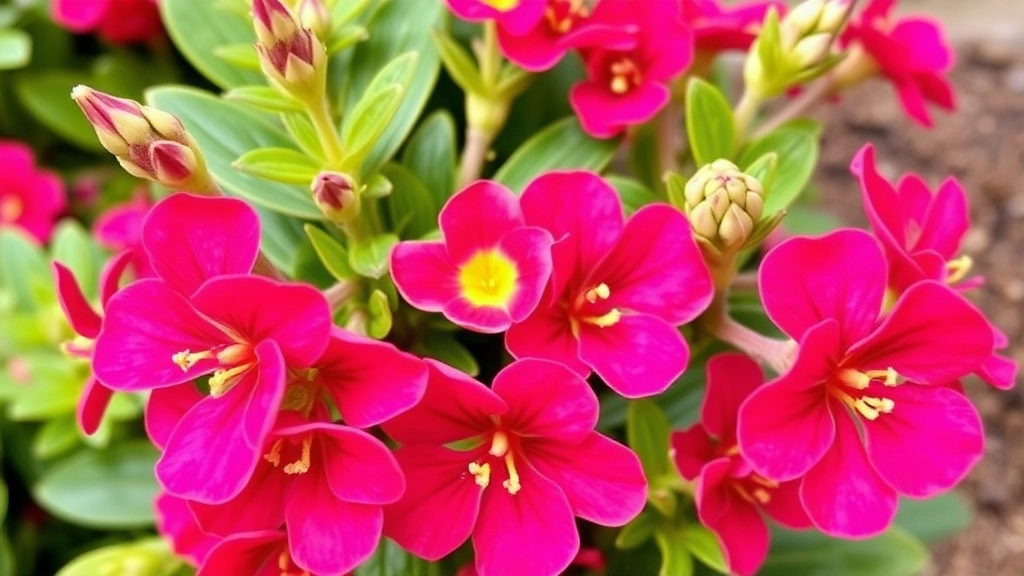Wondering if Kalanchoe blooms all summer?
Typically, these vibrant plants flower from late winter to early spring. However, with the right care, you can extend their blooming period into the summer months. Let me share some tips on how to keep your Kalanchoe flowering longer.
Tips to Prolong Kalanchoe Blooms
To prolong Kalanchoe blooms, ensure they receive optimal indirect sunlight and maintain a consistent watering schedule. Fertilising and deadheading spent blooms are also crucial. Additionally, encouraging a rest period in the fall and manipulating light conditions can help induce summer blooming.
Follow These Steps
Follow these steps, and your Kalanchoe could be a summer showstopper!
Factors That Influence Kalanchoe Blooming
Are you struggling to get your Kalanchoe to bloom? You’re not alone. Many enthusiasts face challenges with these vibrant plants, and understanding the factors that influence their blooming can make all the difference.
1. Light Exposure
- Kalanchoe thrives in bright, indirect sunlight.
- Insufficient light can lead to fewer blooms, while too much direct sunlight can scorch the leaves.
2. Temperature
- Ideal temperatures range between 18°C to 24°C.
- Extreme temperatures can hinder blooming, so maintaining a stable environment is essential.
3. Watering Practices
- Overwatering can cause root rot, while underwatering leads to stress.
- A balanced watering routine is crucialâallow the soil to dry out between waterings.
4. Fertilisation
- Regular feeding during the growing season encourages blooming.
- Use a balanced fertiliser every few weeks for optimal results.
5. Potting Conditions
- Well-draining soil is vital for Kalanchoe health.
- Ensure your pot has drainage holes to prevent water accumulation.
For more detailed information on ensuring your Kalanchoe blooms, check out our guide on why your Kalanchoe is not flowering. Additionally, if you’re interested in the post-bloom care of your plant, our complete guide to caring for Kalanchoe after flowering can provide valuable insights.
Best Practices for Prolonging Summer Blooms

Have you ever wondered how to keep your Kalanchoe blooming all summer long?
It can be frustrating when those vibrant flowers start to fade. But fear not! There are some straightforward practices you can adopt to extend those beautiful blooms.
1. Optimal Watering:
- Consistency is Key: Water your Kalanchoe when the top inch of soil feels dry.
- Avoid Overwatering: Too much water can lead to root rot, which is a sure way to ruin your summer display.
2. Fertilisation:
- Use a Balanced Fertiliser: A diluted, balanced fertiliser every month can work wonders.
- Feed During Active Growth: Make sure to fertilise when your plant is actively growing, usually in spring and summer.
3. Pruning:
- Regular Deadheading: Snip off spent flowers to encourage new growth.
- Trim for Shape: A little trim can help the plant focus energy on blooming rather than maintaining old foliage.
4. Provide Adequate Light:
- Bright, Indirect Sunlight: Kalanchoe loves light but avoid harsh direct sun that can scorch the leaves.
- Rotate Your Plant: Give all sides equal exposure by rotating your pot every week.
5. Temperature Control:
- Keep it Cozy: Kalanchoe thrives in temperatures between 20-25°C during the day.
- Avoid Cold Drafts: Keep your plant away from chilly windows or air conditioning vents.
## Light and Watering Requirements for Summer Growth
When it comes to keeping your Kalanchoe thriving during the summer, light and watering are crucial factors that can make or break your blooming success.
### Light Requirements
Kalanchoe plants love bright, indirect sunlight. Here are some key points to consider:
– **Location**: Place your Kalanchoe near a south or west-facing window to ensure it gets ample light.
– **Duration**: Aim for about 6 hours of light daily. Too little light can lead to leggy growth and fewer blooms.
– **Avoid Direct Sun**: While they enjoy brightness, harsh direct sunlight can scorch the leaves. A sheer curtain can help filter the light.
### Watering Requirements
Proper watering is essential for healthy growth and vibrant blooms. Follow these guidelines:
– **Frequency**: Water your Kalanchoe when the top inch of soil feels dry. This usually translates to once every week or two during the summer.
– **Method**: Ensure you water thoroughly, allowing excess water to drain from the bottom. This prevents root rot.
– **Humidity**: Kalanchoe prefers lower humidity levels, so avoid misting the leaves. Instead, maintain a consistent watering schedule.
By understanding these light and watering requirements, you can create an ideal environment for your Kalanchoe to flourish. For more detailed tips, check out our [complete care guide for Kalanchoe Flapjack Plant](https://planthq.org/complete-care-guide-for-kalanchoe-flapjack-plant/) and learn about [optimal watering tips for healthy Florist Kalanchoe](https://planthq.org/optimal-watering-tips-for-healthy-florist-kalanchoe/).
How to Deadhead Kalanchoe for Continuous Flowering

Have you ever felt disheartened seeing your Kalanchoe lose its vibrant blooms?
Deadheading is the key to keeping your Kalanchoe looking fresh and encouraging new flowers to emerge.
What is Deadheading?
Deadheading is the process of removing spent flowers from your plant. This not only improves the plant’s appearance but also promotes further blooming.
Steps for Effective Deadheading:
- Identify the Spent Flowers:
- Look for flowers that are wilting, browning, or have fallen off.
- Use Clean Tools:
- A pair of sharp scissors or pruning shears will do the trick. Ensure they are clean to prevent disease.
- Cut Just Above the Leaf Node:
- Make your cut about 1 cm above the nearest leaf node. This encourages new growth from that point.
- Remove Any Yellowing Leaves:
- Along with spent flowers, trim away any yellow or unhealthy leaves to keep your plant healthy.
- Dispose of Clippings Properly:
- Ensure you discard the removed flowers and leaves to prevent any pests or diseases.
Why Deadheading Matters:
- Encourages More Blooms:
- By removing old flowers, you signal to the plant that it’s time to produce more blooms.
- Maintains Plant Health:
- Regular deadheading can prevent fungal infections and pests from taking hold.
- Enhances Aesthetics:
- A tidy plant is always more visually appealing, making your space feel more vibrant.
Common Blooming Problems and Solutions
As we delve into the challenges faced by Kalanchoe enthusiasts, it’s essential to recognise that blooming issues can stem from various factors.
1. Lack of Blooms
Problem: If your Kalanchoe is not blooming, it may be due to insufficient light or improper watering.
Solution:
- Ensure your plant receives bright, indirect sunlight for at least 6 hours a day.
- Avoid overwatering; let the soil dry out between waterings to prevent root rot.
2. Wilting Flowers
Problem: Wilting flowers can be alarming, often indicating stress.
Solution:
- Check for underwatering or overwatering. Adjust your watering schedule accordingly.
- Ensure proper drainage in the pot to prevent water accumulation.
3. Fading Colours
Problem: If the vibrant colours of your Kalanchoe start to fade, it might be a sign of nutrient deficiency or too much direct sunlight.
Solution:
- Consider using a balanced fertiliser every few weeks during the growing season.
- Move the plant to a location with filtered light to protect it from harsh sun rays.
4. Leaf Drop
Problem: Leaf drop can be a distressing issue, often linked to environmental changes.
Solution:
- Maintain a consistent environment; sudden changes in temperature or humidity can lead to stress.
- Regularly inspect for pests, as infestations can also cause leaf drop.
5. Pest Infestation
Problem: Pests like aphids or mealybugs can wreak havoc on your Kalanchoe’s blooms.
Solution:
- Regularly inspect your plant for signs of pests.
- Use insecticidal soap or neem oil to treat any infestations promptly.
For more detailed advice on caring for your Kalanchoe, check out our Complete Guide to Kalanchoe Plant Care. If you are specifically dealing with issues related to the Blossfeldiana variety, our Complete Care Guide for Kalanchoe Blossfeldiana offers targeted solutions.
Encouraging Reblooming Through Dormancy Techniques
So, you’ve enjoyed those stunning Kalanchoe blooms all summer long, but now you’re wondering how to get them to flower again, right?
Well, the secret often lies in understanding dormancy.
Just like us, plants need a break to recharge. Here’s how you can encourage your Kalanchoe to bloom again after its summer show:
- Reduce Watering: Once the blooming period ends, cut back on watering. Let the soil dry out a bit more than usual. This simulates a natural dormancy period.
- Lower Light Exposure: Move your Kalanchoe to a spot with less direct sunlight. Aim for bright, indirect light. This helps the plant rest and prepare for its next blooming phase.
- Temperature Control: Keep your plant in a cooler environment, ideally between 15°C to 18°C (59°F to 65°F). This mimics the natural conditions many Kalanchoe varieties thrive in during their dormant phase.
- Fertiliser Break: Hold off on fertilising during dormancy. This gives your Kalanchoe a chance to focus its energy on resting rather than growing.
- Timing: Aim for a dormancy period of about 6 weeks. After this, gradually reintroduce water and light to kickstart new growth.
By following these simple steps, you’ll set the stage for a vibrant rebloom. For more detailed care instructions, check out our Optimal Care for Kalanchoe Blossfeldiana Growth guide. Additionally, if you’re looking to expand your Kalanchoe collection, don’t miss our Discover 150 Species of Kalanchoe Succulent Plants article.
FAQs on Kalanchoe Blooming All Summer
Do Kalanchoe bloom all summer?
Kalanchoe can bloom all summer with proper care, including consistent watering, balanced fertilisation, regular deadheading, adequate light, and temperature control.
What is the optimal watering schedule for Kalanchoe?
Water your Kalanchoe when the top inch of soil feels dry. Avoid overwatering to prevent root rot.
How often should I fertilise my Kalanchoe?
Use a diluted, balanced fertiliser every month during the active growth periods in spring and summer.
Why is deadheading important for Kalanchoe?
Deadheading removes spent flowers, encouraging new blooms and maintaining the plant’s health and appearance.
How do I deadhead my Kalanchoe effectively?
Identify wilting or browning flowers, use clean tools to cut just above the leaf node, and remove any yellowing leaves to keep the plant healthy.
What kind of light does Kalanchoe need?
Kalanchoe thrives in bright, indirect sunlight. Avoid harsh direct sun to prevent leaf scorch and rotate the plant weekly for even light exposure.
What temperature is ideal for Kalanchoe?
Kalanchoe prefers temperatures between 20-25°C during the day. Keep it away from cold drafts and air conditioning vents.
How can I prevent pests and diseases in my Kalanchoe?
Regular deadheading and removing unhealthy leaves can prevent fungal infections and pests. Also, ensure you use clean tools and dispose of clippings properly.
References
-
How To Deadhead Kalanchoe: Tips For Deadheading Kalanchoe Plants
-
How to Grow Kalanchoe Indoors
-
Kalanchoe: How to Grow and Care for Kalanchoe Plants
